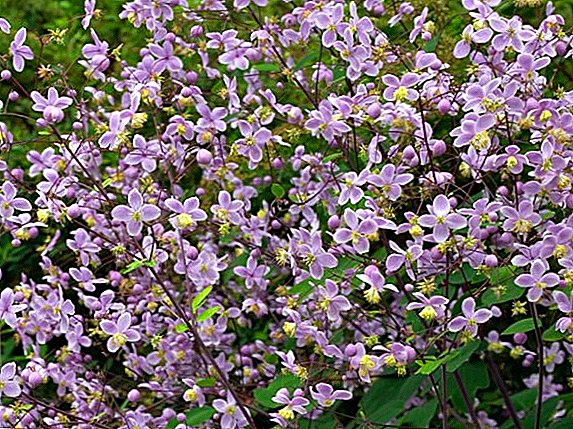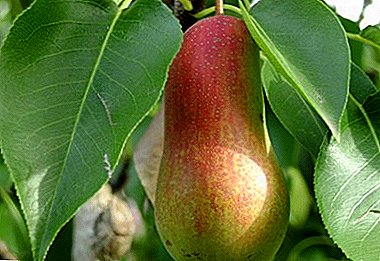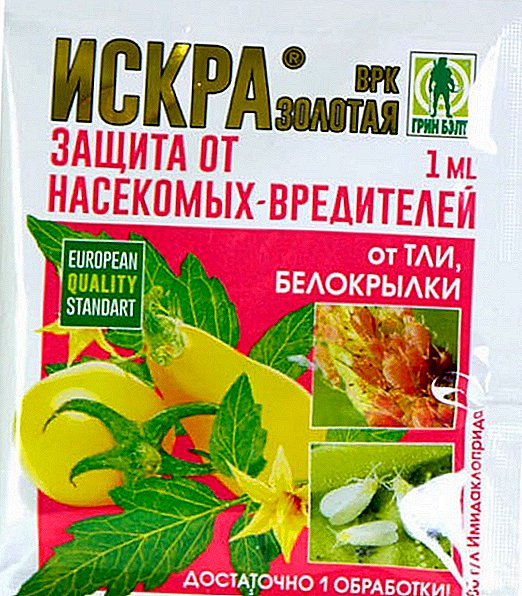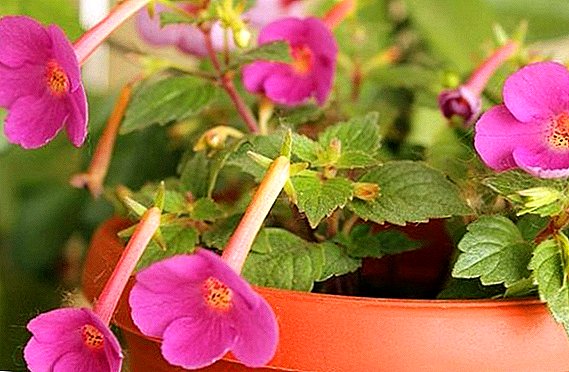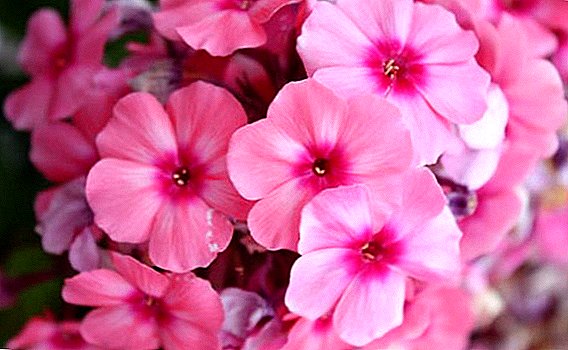 One of the most popular plants in landscape design flower growers call styloid phlox.
One of the most popular plants in landscape design flower growers call styloid phlox.
Botanical description
The phlox is styloid, although it belongs to ground cover plants, it is still significantly different from them. It combines all the advantages of this species, but charming flowers emphasize its striking individuality.
Did you know? Translated from the Greek language "phlox" means "flame".
The view perfectly survives in conditions of frost, drought and has no special requirements for the ground. It blooms in early spring, and with good care and favorable conditions, even in autumn. The flower keeps its decorative pads during the whole winter.
The historical homeland of this plant is North America. However, since the 17th century, growers began to import this culture to Europe. Over the past century, breeders interested in the styloid phlox have created many hybrids and varieties that have acquired a number of amazing advantages. They accelerated the growth of phlox, endowed it with lush blooms. 
Despite all the efforts, in our climatic conditions phlox does not produce seeds. For such reproduction gardeners use foreign materials. Although the variety of inflorescences is very large, white, pink, purple and blue are most common. The diameter of one color reaches about 2.5 cm.
Purple Phlox
White 
Pink
Did you know? Original untouched selection of bushes can be found in eastern North America.It is curious that to grow such an amazing plant is not difficult at all. Although phlox awl has special rules for planting and care.
Growing conditions
The main condition for growing is a sunny place and rather dry soil. Penumbra is acceptable. Extremely dangerous can be a strong soak in the spring. This is due to the fact that the root system is only 5-10 cm deep and the soil layer of the plant is small. There are also standard requirements: weeding, dressing and rare watering. But as mentioned above, it is very important to choose the right place in which your phlox will grow.
There are also standard requirements: weeding, dressing and rare watering. But as mentioned above, it is very important to choose the right place in which your phlox will grow.
A place
Aloe phlox grows best in a dry and sunny place. Every 5 years, the plant must be replanted. This will allow flowering to remain as long and lush.
Important! Flowers endure the winter, but it is important that the roots are covered with a decent layer of snow. Therefore, carefully choose the right place.With his selection should pay attention to the ground.
The soil
Important for the cultivation is the ground. Surprisingly, phlox requires poor, loose and dry soil. Acidity should be weakly alkaline or completely neutral. On succulent chernozems, these plants will give a lot of greenery, but you will hardly wait for them to bloom. If the soil is inappropriate, it can always be changed. If the soil is clay, then before planting a plant just add sand. Lime or dolomite flour is added to the acidic soil. The amount is about 300 g / m2.
When preparing the soil for planting, carefully remove perennial weeds with roots. In the future, you can not remove them without harm to the plant. When the soil is ready, you can go to the planting phlox.
Best neighbors for phlox on a bed will be Alpine daisy, geranium, Dianthus deltoides, undersized bells, cornflowers, Astilbe, Siberian iris, lungwort, primrose, more successful combination of phlox with lilies, delphiniums, helenium, oriental poppy, kampanulami, peonies, lupine, feverfew ;
How to plant styloid phlox
Phlox planting is quite specific - no deeper than 15 centimeters. This is due to the fact that his roots are short. It is necessary to plant bushes at a distance of 20-30 cm. It is best to plant a plant when it is warm, for example, in April. Planted during this period, the plants are very strong and strong. Flowering occurs from May to June. However, you can plant and replant at any time. After planting the flower requires careful care. The plant propagates in several ways, so that for planting you can choose the one that you find most attractive for yourself.
Seeds
Given that our seed styloid phlox does not seed, seed multiplication is extremely rare. If you do decide, the season for you will start very early. To plant seeds in open ground need at the end of winter. By early spring, you have already sprouted shoots. When on sprouts will be on several leaves, you can replant seedlings. The soil should always be wet. Since not everyone has seeds, and the process itself is very long, it is easier to take ready-made shoots.
If you do decide, the season for you will start very early. To plant seeds in open ground need at the end of winter. By early spring, you have already sprouted shoots. When on sprouts will be on several leaves, you can replant seedlings. The soil should always be wet. Since not everyone has seeds, and the process itself is very long, it is easier to take ready-made shoots.
Cuttings
Cutting is the easiest way.  To do this, you can not prepare the cuttings specifically, but use inadvertently broken branches. The lower part of the branch should be cleaned of foliage and prikopat on a shady area. Then just follow the engraftment of the cutting. Instead of branches for breeding, you can use the whole bush.
To do this, you can not prepare the cuttings specifically, but use inadvertently broken branches. The lower part of the branch should be cleaned of foliage and prikopat on a shady area. Then just follow the engraftment of the cutting. Instead of branches for breeding, you can use the whole bush.
Dividing bush
Shrub dividing is the most common breeding method.. For this purpose, the overgrown phlox bushes are ideal. The plant must be dug, and then divided into several small bushes. Each such part should have a piece of the root system. Use this method is best in the spring. No matter how you decide to reproduce phlox, the rules for caring for the plant itself are always the same.
For this purpose, the overgrown phlox bushes are ideal. The plant must be dug, and then divided into several small bushes. Each such part should have a piece of the root system. Use this method is best in the spring. No matter how you decide to reproduce phlox, the rules for caring for the plant itself are always the same.
Care rules
Although phlox blooms very violent and lasts about three weeks, they do not need special care. As a rule, flower growers only prune wilted flowering and clean up the shape of the bushes. Otherwise, they are unpretentious, and do not require excessive care. The principle of watering in phlox is also unusual.
Watering
Phlox likes dry soil and, in principle, does not need watering. However, if a prolonged drought occurs, it is advisable to water it regularly, otherwise it will quickly lose its attractive appearance.  Despite the fact that the plant is very unpretentious, it is still necessary to feed it.
Despite the fact that the plant is very unpretentious, it is still necessary to feed it.
Fertilizers
Annual phloxes are fed about 4 times per season, but perennial all 5. That's just too much to get involved in this. With an abundance of mineral fertilizers greens will be riotous, but the flowering will be mild. 
The first fertilizer is better to start in late spring. To do this, use fertilizers in proportion: 25 g per 10 liters of water. In early June, the procedure must be repeated by adding superphosphates. In early July, you need to feed on the original scheme, without additives. But at the end of July you need to feed with phosphate salt and potassium. It is best to perform the procedure in the evening.
Phloxes can also be fed with fertilizers such as ammonium nitrate, superphosphate, wood ash, chicken manure, potash salt, and feeding supplements should be carried out after rain or pre-irrigation.
Also phlox can be fertilized with ashes. To do this, take 350 g and add 2 liters of water. Then boil for 10 minutes and cool. Then it remains only to drain and pour a bucket of water. This mixture can be used for both roots and foliage.
Pruning
Pruning need to be after the flowering or when the bush grows too much. In winter, only dry branches can be cut. This will allow phlox in the spring to grow young shoots. If you cut the flowers in time, you can provoke repeated flowering. Regular pruning also contributes to the growth of strong shoots. Phlox will maintain a presentable healthy appearance longer. Radical pruning in February will significantly rejuvenate it.
Regular pruning also contributes to the growth of strong shoots. Phlox will maintain a presentable healthy appearance longer. Radical pruning in February will significantly rejuvenate it.
Wintering features
Phloxes endure the winter, but in the northern areas they still require some shelter. Coniferous spruce branches are most often used to cover the root system, but spruce is best suited, so you will avoid soil oxidation. Dry leaves are not suitable for this purpose. 
Important! If the winter is wet and warm with abundant snow, the plant stems and leaves may sweep.After wintering, the bushes often look shabby, but correct pruning will correct the situation. After winter, water the bushes with humus. This will accelerate their growth and root development. Winter is not the only thing that can be harmful. These plants are also prone to disease.
Pests and diseases of the bush
Most often phlox suffer from powdery mildew and variegation. You recognize them by white bloom and an ugly pattern, respectively. Using bordeaux fluid, you can prevent such diseases. However, if you have already noticed the disease, it is better to remove the affected plants in order to avoid its spread. In addition to these common diseases, septoria is also found, it is expressed in brown spots on the foliage. When fomoze leaves dry, and shoots become fragile. In the case of their identification, process the bushes and the soil around the Bordeaux mixture. The procedure will need to be repeated after two weeks.
You recognize them by white bloom and an ugly pattern, respectively. Using bordeaux fluid, you can prevent such diseases. However, if you have already noticed the disease, it is better to remove the affected plants in order to avoid its spread. In addition to these common diseases, septoria is also found, it is expressed in brown spots on the foliage. When fomoze leaves dry, and shoots become fragile. In the case of their identification, process the bushes and the soil around the Bordeaux mixture. The procedure will need to be repeated after two weeks.
Important! The air temperature during processing must be at least + 18º C.If the bushes attacked filamentous worms, then the plants must be dug out and destroyed, and the soil itself should be sprayed with nematocides. With proper cultivation techniques and care, phlox will please you with its abundant flowering.






